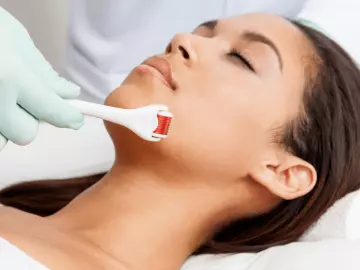The Rise of Derma Rolling
Derma rolling has experienced a surge in popularity over the last few years, and with celebrity fans like Jennifer Aniston attributing her youthful complexion to the treatment, it’s easy to see why. However, plenty of people are still unsure about derma rolling, so we’ve put together an overview as well as some dos and don’ts regarding this revolutionary skin improvement therapy.
What is Derma rolling?
Derma rolling, or medical micro-needling as it’s also known, is a form of Collagen Induction Therapy (CIT) that significantly improves the appearance of fine lines, wrinkles, sun damaged skin, acne scars and stretch marks.
The procedure involves the use of a sterile, single-use handheld device (either a manual derma roller or an automatic ‘pen’) to introduce a series of fine, sharp needles into the surface of the skin, usually after a topical anaesthetic has been applied. The device is moved across the skin, creating thousands of microscopic channels to specifically targeted areas.
How does it work?
The micro channels created during a session of derma rolling will vary in depth according to the problem being targeted. Shallow channels that target the epidermis allow for topical treatments to be absorbed more easily, making them more effective, while slightly deeper channels or ‘micro injuries’ work by encouraging the body to produce collagen and elastin to repair this damage. It’s these proteins that are responsible for the structure and elasticity of the skin, and increased levels of both leads to thicker, plumper, healthier looking skin, as well as a reduction in the appearance of pores, scars, age spots and stretch marks.
For more information about the procedures, including before and after photos, take a look at our recent blog post.
Dos and Don’ts
Derma rolling should only ever be carried out by a trained medical practitioner in an appropriate setting – but even a cursory search online will reveal many companies that sell ‘home rolling kits’. These should be avoided at all costs as they can be dangerous.
One of the major concerns regarding home rolling is the potential to ‘overdo’ the treatment – something that is easy to do if you’re not properly qualified.
Pressing too hard or repeatedly targeting the same areas can create deeper pathways or tears in the skin, which will not only take longer to heal, but will also leave the skin open to infection or reaction to any products that are applied.
A professional practitioner will only ever create controlled areas of damage, and will always leave an appropriate amount of time between treatments. For those with kits at home, it can be tempting to use them too often, leaving the skin in a state of constant, painful inflammation.
As well as ‘at home’ kits, you may also find unqualified professionals advertising their derma rolling services. Again, these should be avoided as these untrained and unregulated individuals can put your skin and health at serious risk of harm.
Unqualified professionals will have had little or no training in administering the procedures. As well as the issues mentioned above, these individuals often use low-quality devices that may not have been sterilised between uses, enabling the transmission of infectious diseases such as HIV and Hepatitis.
Save Face
At Save Face we cannot stress enough the importance of going to a properly qualified practitioner for whatever non-surgical cosmetic treatments you may be interested in.
Don’t be tempted by cheap deals that you may come across on the Internet. Whilst you may save a few pounds initially, you could end up paying dearly when it comes to your health.
Use the Save Face search engine to find a suitably qualified practitioner who has undergone strict vetting procedures to become Save Face Accredited, and make sure that you don’t fall foul to unethical and untrained cowboys.


